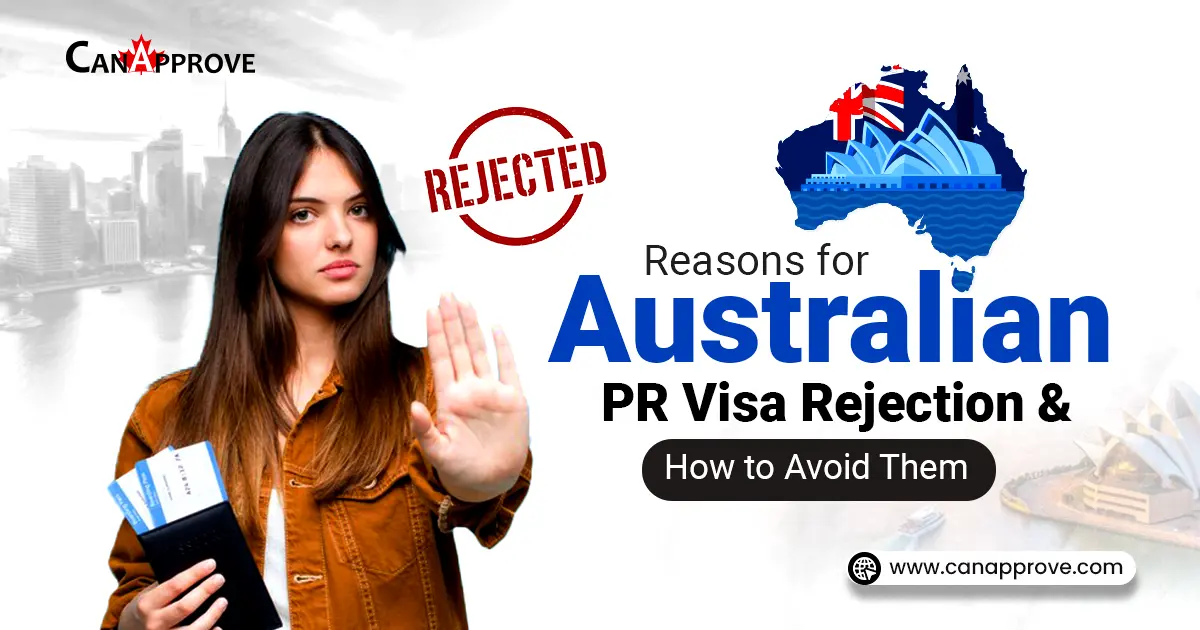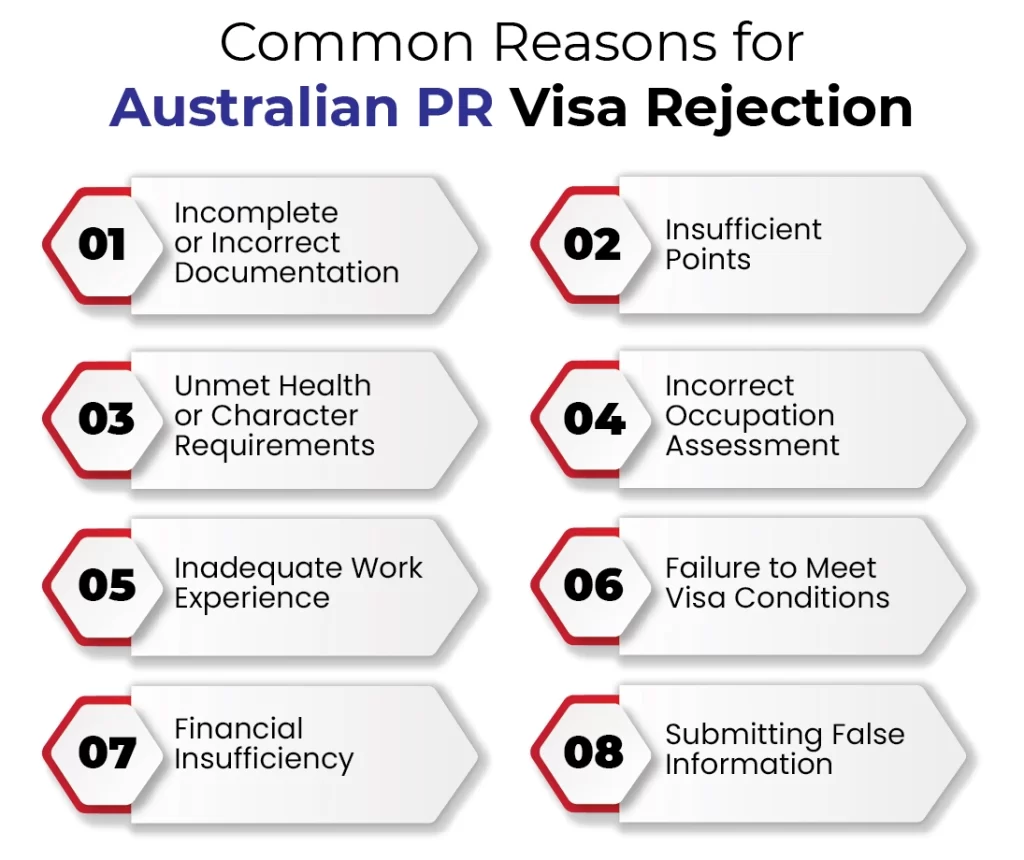Australian PR Visa Rejection can be really heartbreaking, right?
Especially after months of preparation and anticipation. Oh man can’t think about that! Understanding why rejections happen and how to avoid them is very much important for a successful PR application.
Whether you’re applying as a skilled worker, dentist in Australia, or pharmacist in Australia, knowing about the process inside-out can help you secure your permanent residency.
Table Of Content
1Common Reasons for Australian PR Visa Rejection2How to Avoid Australian PR Visa Rejection3Difference between Revoked and Cancelled Visa4Australia PR Visa Rejection Rate5How CanApprove helps you get Australian PR6Frequently Asked Questions
Common Reasons for Australian PR Visa Rejection
Many applicants face Australian PR Visa Rejection due to avoidable errors. Common causes include:
1. Incomplete or Incorrect Documentation
Submitting incomplete or inconsistent documents is one of the top reasons for rejection. This includes:
- Incorrectly filled application forms
- Missing police clearance certificates
- Expired language test results (like IELTS/PTE)
Tip: Double-check every document before submission!
2. Insufficient Points
Australia’s PR visa system (SkillSelect) operates on a points-based system. Falling short of the required points (usually 65+) can lead to automatic rejection.
Tip: Check if you can claim additional points through:
- Partner skills
- State/Territory nomination
- Professional year program
3. Unmet Health or Character Requirements
Failing the health or character test is a deal-breaker. Applicants with serious medical conditions or criminal records often face rejection.
4. Incorrect Occupation Assessment
Choosing the wrong occupation from the Skilled Occupation List (SOL) or providing incorrect skills assessment reports can result in rejection.
Tip: Always consult with a registered migration agent to ensure you’re on the right track.
5. Inadequate Work Experience
Claiming work experience that cannot be verified, or not meeting the minimum experience requirements can weaken your application.
6. Failure to Meet Visa Conditions
Breaching previous visa conditions or overstaying can negatively impact your PR application.
7. Financial Insufficiency
In some cases, failure to prove sufficient funds for initial settlement may trigger rejection.
8. Submitting False Information
Providing fraudulent documents or false claims can result in an immediate rejection and even a ban from applying in the future.
How to Avoid Australian PR Visa Rejection
Avoiding an Australian PR Visa Rejection starts with careful planning, professional support, and understanding what the Department of Home Affairs expects from your application. Here’s how you can stay on the right track:
1. Understand the Visa Requirements Thoroughly
Each visa subclass has specific eligibility criteria. Make sure you meet:
- Age, education, and English proficiency benchmarks
- Health and character requirements
- Minimum points threshold (for Skilled PR)
Tip: Refer to the official SkillSelect points calculator before applying.
2. Get a Valid Skills Assessment
Your occupation must be listed in the Skilled Occupation List, and you must get a positive skills assessment from the relevant assessing authority.
Tip: Make sure your work experience and qualifications match the selected occupation.
3. Keep All Documents Accurate & Up-to-Date
- Work reference letters
- Language test results
- Police and medical clearance
Tip: Have a document checklist and get them verified by a professional.
4. Be Honest & Transparent
Never try to conceal information or submit false documents. The Australian government has a strict stance on integrity. Misrepresentation can lead to bans.
5. Meet the English Language Criteria
Even if you’re a fluent speaker, failing to provide valid test scores (IELTS, PTE, TOEFL) can result in rejection.
Tip: Aim for scores that exceed the minimum requirement to boost your points.
6. Choose the Right Visa Subclass
Applying under the wrong category is a common but costly mistake. Some applicants qualify better under subclass 190 (state nominated) or 491 (regional) rather than 189.
Difference Between Revoked and Cancelled Visa
Although the terms “visa cancellation” and “visa revocation” are often used interchangeably, they hold different meanings depending on the immigration systems of different countries.
Cancelled Visa (Common in Australia)
- Used in countries like Australia.
- Definition: The visa is officially withdrawn after it was granted—you lose your legal right to remain or enter.
- Who does it? The immigration department or the Minister.
- Reasons:
- Breach of visa conditions
- Providing false information
- Security or character concerns
- Changes in eligibility (like dropping out of a course)
Revoked Visa (Common in the U.S. and some other countries)
- Used more commonly in the United States.
- Definition: A previously approved visa is declared invalid, often before the holder uses it.
- Who does it? The issuing authority (e.g., U.S. Department of State).
- Reasons:
- Misrepresentation during the application
- Security or public safety threats
- A change in U.S. law or policy
- New info that makes you ineligible
Key Differences:
| Aspect | Cancelled Visa (e.g., Australia) | Revoked Visa (e.g., U.S.) |
|---|---|---|
| Usage | Common in Australia | Common in the U.S. |
| Timing | After visa is granted | Often before the visa is used |
| Main Authority | Immigration Minister/Department | U.S. Department of State |
| Grounds | Violation of visa conditions, character | National security, misrepresentation |
| Affects Re-entry | Yes (re-entry bans may apply) | Yes (future applications impacted) |
Australia PR Visa Rejection Rate
As of 2025, the Australian PR visa rejection rate is not publicly disclosed in official statistics. However, based on available data and trends, the rejection rate for Australia PR visas is estimated to be around 15% to 20%. This estimate is derived from various sources and reflects the tightening of immigration policies and increased scrutiny of applications.
It’s important to note that rejection rates can vary depending on the visa subclass, applicant’s country of origin, and other factors. For instance, student visa rejection rates have seen a significant increase, with reports indicating a 50% rejection rate in the academic year 2023-2024 . While this pertains to student visas, it underscores the broader trend of stricter immigration controls that could also impact PR visa approvals.
What Happens After an Australian PR visa Rejection
An Australian PR visa rejection doesn’t mean the end of your Australian dream. You can:
- Appeal to the Administrative Review Tribunal (ART)
- Reapply after correcting errors
- Consult with immigration experts like CanApprove for tailored guidance
How CanApprove helps you get Australian PR
CanApprove provides end-to-end support throughout your Australia PR process. From evaluating your PR eligibility to preparing documentation, applying for Australian skill assessments, and appealing rejections — we simplify your journey toward permanent residency. We’ve helped many applicants successfully migrate from India and other countries, even in challenging cases.
Don’t say we didn’t warn you! Get in touch with us to reduce your refusal chances of an Australian PR visa, thereby ensuring smooth immigration to Australia.







